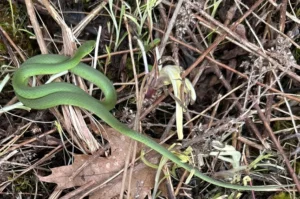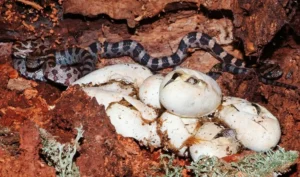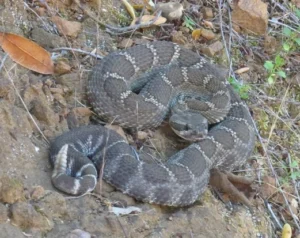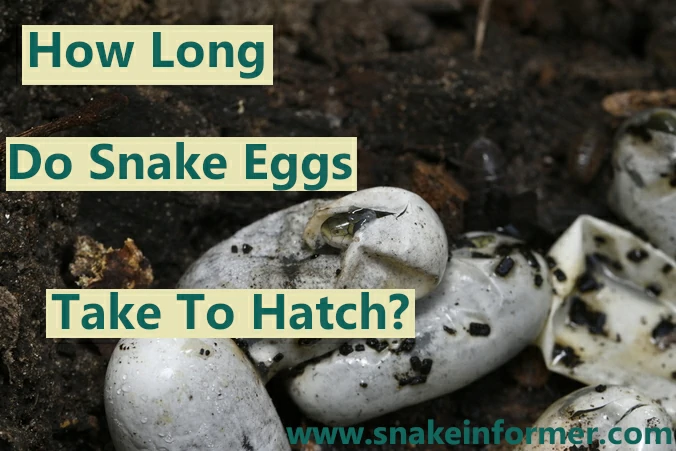When the winter ends and the warmer spring temperatures come, many snakes will emerge from their overwintering spots, and begin the mating season. But have you ever wondered how long snake eggs take to hatch?
Generally, snake eggs take between 45 and 70 days to hatch, depending on the species and environmental conditions. Snake eggs will typically develop and hatch faster in warmer temperatures, and slower in colder temperatures.
That said, it’s important to note that not all snakes lay eggs.
Some species are ovoviviparous or viviparous, meaning they give birth to live young (more information on that is below).
How Long the Eggs of 70 Snake Species Take to Hatch
There are over 4,000 species of snakes around the world.
They live in a very wide range of habitats, from humid forests, to dry regions.
Different species of snakes have adapted to their environments and developed breeding methods that are practical for the areas where they live.
How long the eggs of a particular snake take to hatch can vary dramatically between species.

The eggs of some snakes such as the smooth green snake (Opheodrys vernalis) typically hatch in less than 30 days – while the eggs of the King Cobra (Ophiophagus hannah) take up to 105 days to hatch.
Below are several tables that show approximately how long the eggs of 70 snake species take to hatch.
Colubrid Snakes (Colubridae)
| Scientific Name | Common Name | Range | Egg Incubation Time |
|---|---|---|---|
| Pantherophis guttatus | Corn Snake | Southeastern US | ~55–65 days |
| Pantherophis obsoletus | Black Rat Snake | Eastern US | ~55–70 days |
| Coluber constrictor | Eastern Racer | Widespread in much of the US | ~40–50 days |
| Storeria dekayi | Dekay’s Brownsnake | Eastern & central US | ~30–40 days |
| Storeria occipitomaculata | Red-bellied Snake | Northeastern US & Canada | ~30–40 days |
| Lampropeltis getula | Eastern Kingsnake | Eastern US | ~55–65 days |
| Lampropeltis triangulum | Milk Snake | Widespread US & Canada | ~55–65 days |
| Opheodrys vernalis | Smooth Green Snake | Northern US & Canada | ~30–40 days |
| Opheodrys aestivus | Rough Green Snake | Southeastern US | ~30–40 days |
| Heterodon platirhinos | Eastern Hognose Snake | Eastern US | ~50–60 days |
| Farancia abacura | Mud Snake | Southeastern US | ~60 days |
| Diadophis punctatus | Ring-necked Snake | Eastern US | ~40–50 days |
| Masticophis flagellum | Coachwhip Snake | Southern US | ~45–55 days |
| Pituophis catenifer | Gopher Snake | Western & central US | ~55–70 days |
| Boiga dendrophila | Mangrove Snake | Southeast Asia | ~60–70 days |
| Boiga irregularis | Brown Tree Snake | Pacific Islands | ~60 days |
| Elaphe climacophora | Japanese Rat Snake | Japan | ~55–60 days |
| Elaphe obsoleta | Asian Rat Snake | East Asia | ~60 days |
| Zamenis longissimus | Aesculapian Snake | Europe | ~45–60 days |
| Coluber caspius | Caspian Whip Snake | Eastern Europe / Asia | ~40–50 days |
| Philodryas patagoniensis | Patagonian Green Racer | South America | ~50–60 days |
| Coronella austriaca | Smooth Snake | Europe | ~40–50 days |
| Telescopus fallax | European Cat Snake | Mediterranean Region | ~50–55 days |
| Drymoluber dichrous | Amazon Racer | South America | ~50 days |
| Dendrelaphis pictus | Painted Bronzeback | South/Southeast Asia | ~45–60 days |
| Philothamnus semivariegatus | Spotted Bush Snake | Africa | ~50 days |
| Psammophis sibilans | African Sand Snake | Africa | ~40–50 days |
| Hierophis viridiflavus | Green Whip Snake | Europe | ~40–60 days |
Elapid Snakes (Elapidae)
| Scientific Name | Common Name | Range | Egg Incubation Time |
|---|---|---|---|
| Micrurus fulvius | Eastern Coral Snake | Southeastern U.S. | ~60 days |
| Micrurus tener | Texas Coral Snake | Texas and northeastern Mexico | ~60–75 days |
| Micrurus browni | Brown’s Coral Snake | Southern Arizona and Mexico | ~60 days (estimated) |
| Micrurus diastema | Variable Coral Snake | Southern Mexico to Central America | ~60 days (estimated) |
| Micruroides euryxanthus | Sonoran Coral Snake | Arizona and northern Mexico | ~50–60 days |
| Naja naja | Indian Cobra | South Asia | ~55–65 days |
| Naja kaouthia | Monocled Cobra | Southeast Asia | ~50–60 days |
| Naja haje | Egyptian Cobra | North Africa & Middle East | ~60–70 days |
| Naja melanoleuca | Forest Cobra | Central & West Africa | ~60–70 days |
| Naja siamensis | Indochinese Spitting Cobra | Southeast Asia | ~55–65 days |
| Naja sputatrix | Javan Spitting Cobra | Indonesia | ~55–65 days |
| Ophiophagus hannah | King Cobra | Southeast Asia | ~60–80 days |
| Pseudonaja textilis | Eastern Brown Snake | Australia | ~55–65 days |
| Notechis scutatus | Tiger Snake (some subspecies) | Southern Australia | ~60–70 days |
| Dendroaspis polylepis | Black Mamba | Sub-Saharan Africa | ~70–90 days |
| Dendroaspis angusticeps | Eastern Green Mamba | Coastal East Africa | ~70–80 days |
| Dendroaspis viridis | Western Green Mamba | West Africa | ~70–80 days (estimated) |
| Dendroaspis jamesoni | Jameson’s Mamba | Central Africa | ~70–85 days |
Pythons (Pythonidae)
| Species (Scientific Name) | Common Name | Egg Incubation Time |
|---|---|---|
| Python regius | Ball Python | ~55–70 days |
| Python bivittatus | Burmese Python | ~60–80 days |
| Python molurus | Indian Python | ~55–72 days |
| Python sebae | African Rock Python | ~65–90 days |
| Python natalensis | Southern African Rock Python | ~60–80 days |
| Python reticulatus | Reticulated Python | ~80–90 days |
| Python anchietae | Angolan Python | ~60 days |
| Python breitensteini | Borneo Short-tailed Python | ~65–75 days |
| Python brongersmai | Blood Python | ~55–65 days |
| Python curtus | Sumatran Short-tailed Python | ~65–70 days |
| Antaresia childreni | Children’s Python | ~50–60 days |
| Antaresia maculosa | Spotted Python | ~50–60 days |
| Antaresia stimsoni | Stimson’s Python | ~50–60 days |
| Morelia spilota | Carpet Python (incl. jungle, coastal) | ~55–70 days |
| Morelia viridis | Green Tree Python | ~50–65 days |
| Liasis fuscus | Water Python | ~50–60 days |
| Liasis olivaceus | Olive Python | ~60–70 days |
| Simalia amethistina | Amethystine Python | ~65–75 days |
Sea Snakes & Sea Kraits
| Scientific Name | Common Name | Egg Incubation Time |
|---|---|---|
| Laticauda colubrina | Yellow-lipped Sea Krait | ~120 days (≈4 months) |
| Laticauda laticaudata | Blue-lipped Sea Krait | ~100–120 days |
| Laticauda semifasciata | Banded Sea Krait | ~90–110 days |
| Laticauda colubrina | Yellow-lipped Sea Krait | ~100–120 days |
| Laticauda laticaudata | Blue-lipped Sea Krait | ~90–110 days |
| Laticauda semifasciata | Banded Sea Krait | ~100–120 days |
Temperature Affects How Long Hatching Takes
Snake eggs are often exposed to a wide range of temperatures depending on the time of year when they are laid.
Temperature affects embryonic development rates. In general, snake eggs will develop and hatch faster in warmer temperatures and slower in colder temperatures.
For example, corn snake eggs are known to hatch in 55–65 days at 82°F (28°C), but may take over 70 days if kept cooler.

Snake eggs best develop at consistent temperatures. Fluctuating temperatures can lead to uneven development or even kill the developing embryos.
Other Factors That Affect Snake Egg Development
Besides temperature, there are other factors that can affect how long it takes snake eggs to hatch.
1. Humidity
The right humidity is essential to keep snake eggs from drying out.
It doesn’t usually directly change the embryo development rate, but poor humidity can kill embryos before they hatch.
Without proper moisture, snake eggs can dry out. On the opposite end, too much humidity can lead to mold growth.
2. Clutch Size
Larger clutches often experience slightly longer embryo development rates, due to uneven heat and oxygen distribution within the clutch.
The eggs at the center of a tightly packed clutch may have lower oxygen levels, and develop slower.
Larger eggs or larger clutches may experience slightly longer incubation periods due to heat and oxygen distribution within the clutch.
3. Parental Care (In Some Species)
Certain snake species, such as green tree pythons (Morelia viridis), care for their eggs.
The female will wrap around her eggs, and use “muscular shivers” to produce heat and regulate the incubation temperature,
Parental care may help eggs hatch faster, in the species where it is present.
Many Snakes Do Not Lay Eggs
Although most snakes reproduce by laying eggs, not all snakes do.
In general, only about 70% of known snake species lay eggs. The rest are either ovoviviparous or viviparous, meaning they give birth to live young.

When ovoviviparous snakes mate, their eggs are fertilized internally and are retained within a uterus formed of fused portions of the oviducts.
The developing embryos are nourished by the egg yolks, and the female will give ‘birth’ to tiny, fully developed baby snakes capable of independent life.
Examples of snakes that do not lay eggs include:
- Garter snakes
- Most vipers in the family Viperidae (rattlesnakes, copperheads, etc)
- Water snakes in the genus Nerodia (plainbelly water snakes, Common water snakes, etc.)
- Boas in the family boidae
- Yellow-bellied Sea Snakes
- Olive Sea Snakes
- Beaked Sea Snakes
Viviparous and ovoviviparous snakes likely evolved from egg-laying (oviparous) ancestors as an adaptation to environmental pressures.
Retaining eggs internally helped protect them from threats like predators, drowning, or temperature extremes.
- Aquatic snakes evolved live birth because they rarely come ashore and suitable nesting sites are limited.
- Arboreal (tree-dwelling) snakes benefit from not having to descend to the ground to lay eggs.
- Snakes in cold climates give live birth due to the scarcity of warm, safe nesting sites.
- Large or venomous snakes (e.g., boas, anacondas, rattlesnakes, vipers) often give live birth because their bodies offer better protection for developing young than exposed nests.
Overall, live birth increases the chances of offspring survival in hostile environments.
Most Snake Eggs Never Get to Hatch
Most snakes leave their eggs shortly after laying them. This means the eggs are vulnerable to predators, and environmental conditions – leading to very low survival rates.
Many snake eggs are eaten by birds, raccoons, rodents, lizards, and even other snakes.
When the young hatch, they will also be heavily preyed on, and most won’t live to adulthood.
Conclusion
Most snakes reproduce by laying eggs, but all do. The snakes that do lay eggs usually lay them in hidden spots where they will be protected from the elements, and from predators.
These eggs will usually hatch within 6 to 10 weeks, but those of some snake species species can take nearly 4 months before they hatch.
If you find snake eggs in the wild, it’s best you leave them alone. Do not touch or handle the eggs in any way.
Snake eggs that are disturbed may not develop correctly. Once laid, they should remain in the same orientation throughout incubation.
Featured image credit: Evan Hessels (CC BY-NC 4.0)
Sources:
Viviparity in Snakes: Some Ecological and Zoogeographical ConsiderationsWilfred T. NeillThe American Naturalist 1964 98:898, 35-55
Kosin, I. & Mun, A.. (1960). Clutch Size, Oviposition Time, and “Floor” Eggs as Factors in Hatchability. Poultry Science. 39. 82-92. 10.3382/ps.0390082.
Hi, my name is Ezra Mushala, i have been interested animals all my life. I am the main author and editor here at snakeinformer.com.

